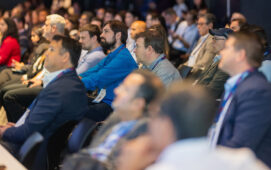
With financial institutions under increasing pressure to modernise their trading infrastructures while maintaining agility and control, the debate around what to buy and what to build in terms of technology solutions is critical. So how should firms weigh the costs and benefits of buying versus building? What role do open-source solutions play in trading systems? And how can organisations manage the complexities of integrating legacy systems with new technologies?
As the financial markets sector grapples with these challenges, a group of industry experts explored the key considerations firms must navigate when deciding whether to buy or build technology components, in a panel session entitled “Moving to a Modern, Component-Based Trading Architecture Using a Buy and Build Approach”. The panel, part of A-Team Group’s recent Buy AND Build: The Future of Capital Markets Technology summit, was moderated by Steve Grob, Founder of Vision57, and featured Gary Collier, CTO at Man Group, Sunny Jaisinghani, Head of Data, Global Custody at State Street, Jon Butler, CEO of Velox, and Mike Gatny, President & COO at Connamara. The conversation covered a range of topics, from the total cost of ownership (TCO) to the role of open-source software, and the complexities of integrating legacy systems with modern solutions.Key Insights: Buy vs. Build
The discussion kicked off by examining the buy vs. build question. One panellist emphasised that firms must look beyond just the upfront cost and consider the total cost of ownership. Buying a solution might seem easier, but ongoing license costs, integration efforts, and a lack of control over the vendor’s roadmap can complicate matters. If a solution lacks robust APIs, firms may find themselves boxed into a rigid system that is difficult to extend or adapt. Another major consideration is vendor viability—can the vendor be relied upon long-term? If not, firms risk being left stranded if the vendor goes out of business.
Building in-house solutions, while giving firms more control over their IP and product evolution, brings its own challenges. The panellists discussed the inherent risks of scope creep, timeline overruns, and the difficulty of estimating budgets. One speaker emphasised that firms should only build what they cannot buy, reserving in-house development for areas that offer a competitive edge or “special sauce.” This perspective resonated with the rest of the panel, which agreed that building is generally more suited to areas where innovation is key.
Legacy Systems and Modernisation
The conversation then turned to how firms can modernise legacy systems. One speaker highlighted the importance of finding a balance between maintaining old systems and overlaying them with more agile technology. He shared how his firm had successfully implemented solutions that sit on top of existing legacy systems, creating a more flexible starting point for future innovations.
Another panellist explained that when it comes to the buy vs. build debate, his firm looks through three key lenses: innovation, efficiency, and agility. Innovation is crucial for driving competitive advantage, efficiency for maintaining operational excellence, and agility for controlling future adaptations. Although this framework has led his firm to build more in-house solutions than he felt was typical in the industry, he emphasised that the answer to buy vs. build is never black and white.
Open Source in Capital Markets
Open-source software was a hot topic, with all panellists agreeing that it plays a crucial role in modern trading architectures. Open-source tools offer the benefit of flexibility without the financial burden of proprietary software. One speaker noted that open-source solutions allow firms to innovate faster while avoiding the risk of “reinventing the wheel.” However, he also stressed the importance of contributing back to the open-source community, rather than simply taking from it.
Another panellist remarked that open-source solutions can now form the bedrock of a firm’s front-office technology, particularly in areas like data science. By leveraging existing open-source tools and combining them with proprietary IP, firms can push the boundaries of innovation.
However, the panel also acknowledged that open source is not without its risks. A key consideration is knowing when to start paying for support from open-source vendors. One speaker noted that his firm is willing to pay when they need assurance of long-term stability and maintenance, especially if the software is critical to their operations.
Managing Vendor Relationships
The panel also explored the complexities of managing relationships with vendors, especially when dealing with large firms. Several speakers pointed out the inherent imbalance between large financial institutions and smaller vendors. Smaller firms often struggle with the onboarding processes and paperwork required by their larger clients, while larger firms can sometimes “bully” smaller vendors with contract terms.
To overcome this, the speakers emphasised the importance of partnerships and collaboration. One panellist shared how his firm had found success by working closely with vendors, integrating their developers into the same codebase, and fostering open-source-like collaboration. This collaborative approach helps ensure transparency, avoid disputes, and align both parties on long-term goals.
Cybersecurity and Governance
Cybersecurity remains a critical issue when integrating external solutions with in-house systems. The panellists agreed that robust security frameworks are essential, especially as partnerships with smaller vendors expose firms to new risks. One speaker explained that his firm approaches risk management by scaling the robustness of security based on the criticality of the system. Smaller vendors are often subject to rigorous internal InfoSec questionnaires to ensure they meet the firm’s standards.
AI and the Future of Buy vs. Build
The session concluded with a discussion on the role of AI within the buy vs. build debate. While generative AI and large language models (LLMs) are hot topics, the panel agreed that AI has not yet reached its full potential in capital markets. One speaker noted that AI is often a solution looking for a problem, but as it evolves, it will inevitably become more integrated into both buy and build strategies.
The panellists agreed that AI’s most immediate impact will be in improving developer productivity, streamlining operations, and incrementally optimising processes. However, they cautioned that without clean and well-organised data, AI’s benefits will remain limited.
In summary, the panel provided valuable insights into how financial firms can navigate the complexities of modern trading architectures using a combination of buying, building, and leveraging open-source tools. Key themes included the importance of total cost of ownership, the need for collaboration between firms and vendors, and the evolving role of AI and open-source in shaping the future of trading technology. While there are no one-size-fits-all solutions, firms that balance innovation with efficiency and agility are well-positioned to succeed in the evolving landscape of capital markets.
Subscribe to our newsletter




